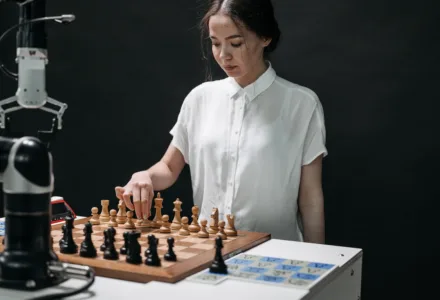Chess bots are computer programs or algorithms designed to play chess autonomously. These bots use artificial intelligence (AI) and advanced algorithms to analyze the chessboard, calculate possible moves, and make decisions similar to how a human chess player would. Chess bots can range from simple programs that make random moves to sophisticated engines that rival top human players in terms of playing strength.
Table of Contents

Here are some common types of chess bots and how they work:
Random Move Chess Bots
These bots make random legal moves on the chessboard without any real strategic or tactical understanding. They are the simplest form of chess bots and are not competitive against human players.
Also Read: Top 10 Chess Players by Fide Rating 2022
Rule-Based Chess Bots
Rule-based bots follow predefined rules and heuristics to make decisions. These rules are usually based on basic chess principles like piece values, controlling the center, and piece development. While better than random move bots, they are still limited in strength.
Search Algorithms Bots
More advanced chess bots use search algorithms like minimax with alpha-beta pruning to explore the possible moves and their consequences. These bots look several moves ahead and evaluate the positions to select the best move.
AI Neural Network Bots
State-of-the-art chess bots often use neural networks and deep learning techniques. They learn from large databases of games played by strong players to improve their understanding of chess positions, patterns, and strategies. Also Read: Benefits of Using Artificial Intelligence in Marketing: The Future of Digital Advertising
Top Chess Engines Bots
Chess engines like Stockfish, Komodo, and AlphaZero are among the strongest chess bots available. They combine advanced search algorithms, positional evaluation functions, and sometimes machine learning to achieve grandmaster-level playing strength.
Online Chess Platforms Chess Bots
Many online chess platforms like Chess.com , Lichess.Org offer bots with different difficulty levels for players to practice against. These bots can simulate a range of playing strengths, from beginner to expert.
Conclusion
Chess bots have played a significant role in advancing computer science, AI research, and chess theory. They have been used to uncover new opening ideas, analyze endgames, and even assist human players in improving their skills. Additionally, chess bots have competed in online and over-the-board tournaments, often achieving high rankings and challenging human players.


